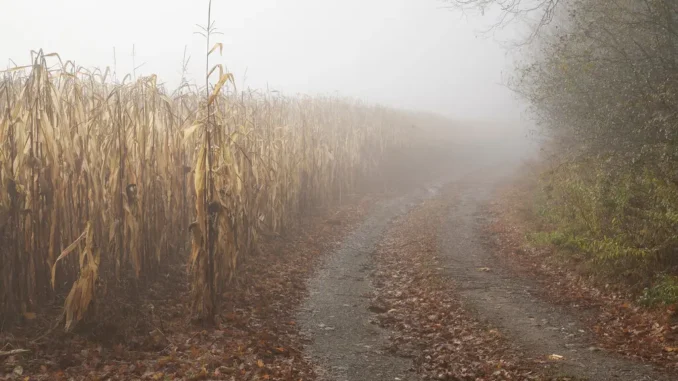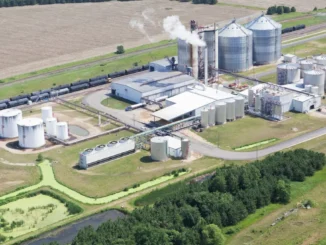
As America rushes to generate more renewable electricity, it has become fashionable to fret that solar and wind farms use too much land. But America is also racing to produce more renewable fuels, and they use much, much more land to displace much, much less fossil fuel.
It’s fairly well-known that farm-grown fuels like corn ethanol and soy biodiesel accelerate food inflation and global hunger, but they’re also a disaster for the climate and the environment. And that’s mainly because they’re inefficient land hogs. It takes about 100 acres worth of biofuels to generate as much energy as a single acre of solar panels; worldwide, a land mass larger than California was used to grow under 4 percent of transportation fuel in 2020.
That’s a huge waste of precious land the world needs to store carbon that can stabilize our warming climate and grow crops that can help feed the growing population. The Environmental Protection Agency could help rein in that waste when it updates America’s sweeping mandate encouraging biofuel production later this month. It probably won’t, though, because in Washington, where cornethanolism is one of the last truly bipartisan ideologies, nearly everyone loves to pretend biofuels are green.
America is no longer an agrarian nation, but it remains an article of faith among its political elites that agrarian interests in the heartland require constant handouts. Government support for blending biofuels into U.S. gasoline is often rationalized on the wink-wink-nudge-nudge grounds of reducing reliance on foreign oil or saving the climate, but it’s mainly a way to suck up to farmers and enrich agribusinesses. Like direct payments, countercyclical payments, loan deficiency payments and other U.S. farm programs, biofuel subsidies redistribute tax dollars from the 99 percent of Americans who don’t farm to the roughly 1 percent who do.
What makes corn-based ethanol distinct from most of our other wasteful agricultural giveaways is that it diverts crops from bellies to fuel tanks and uses almost as much fossil fuel — from fertilizers made of natural gas to diesel tractors, industrial refineries and other sources — as the ethanol replaces.
But the more damaging effect of biofuels, first revealed in a 2008 paper in the journal Science, is that they increase greenhouse gas emissions through the conversion of carbon-rich forests, wetlands and grasslands into farmland, expanding our agricultural footprint while shrinking nature’s. That was tragic back when biofuels seemed like the only plausible alternative to planet-broiling gasoline, but it’s inexcusable now that electric vehicles have become better, cleaner and more economical. Biofuels are like a return to the horse-and-buggy era, when farmers had to grow millions of acres of oats and hay for transportation fuel, except now the crops are processed through ethanol plants instead of animals.
By 2050, the world will need to grow an additional 7.4 quadrillion calories every year to fill nearly 10 billion bellies, while ending deforestation and other wilderness destruction to meet the emissions targets in the Paris climate accord. Biofuels make both jobs much harder.
But President Biden, like Presidents George W. Bush, Barack Obama and Donald Trump before him, pledged fealty to ethanol before competing in the Iowa caucus, because ethanol mandates jack up the price of corn and win voters. The presidential candidates John McCain, Bernie Sanders and Michael Bloomberg all retracted their criticisms of biofuels before the Iowa caucus, too. An episode of “The West Wing” captured the dilemma well when a presidential candidate who wanted to break the tradition of wooing Iowa farmers with over-the-top ethanol promises quipped, “It’s practically in the Oxford English Dictionary under ‘pandering.’”
“Bambi would have a better shot of getting elected president of the N.R.A. than you’ll have of getting a single vote in this caucus,” his political aide replied.
But the more damaging effect of biofuels, first revealed in a 2008 paper in the journal Science, is that they increase greenhouse gas emissions through the conversion of carbon-rich forests, wetlands and grasslands into farmland, expanding our agricultural footprint while shrinking nature’s. That was tragic back when biofuels seemed like the only plausible alternative to planet-broiling gasoline, but it’s inexcusable now that electric vehicles have become better, cleaner and more economical. Biofuels are like a return to the horse-and-buggy era, when farmers had to grow millions of acres of oats and hay for transportation fuel, except now the crops are processed through ethanol plants instead of animals.
By 2050, the world will need to grow an additional 7.4 quadrillion calories every year to fill nearly 10 billion bellies, while ending deforestation and other wilderness destruction to meet the emissions targets in the Paris climate accord. Biofuels make both jobs much harder.
But President Biden, like Presidents George W. Bush, Barack Obama and Donald Trump before him, pledged fealty to ethanol before competing in the Iowa caucus, because ethanol mandates jack up the price of corn and win voters. The presidential candidates John McCain, Bernie Sanders and Michael Bloomberg all retracted their criticisms of biofuels before the Iowa caucus, too. An episode of “The West Wing” captured the dilemma well when a presidential candidate who wanted to break the tradition of wooing Iowa farmers with over-the-top ethanol promises quipped, “It’s practically in the Oxford English Dictionary under ‘pandering.’”
“Bambi would have a better shot of getting elected president of the N.R.A. than you’ll have of getting a single vote in this caucus,” his political aide replied.
But the more damaging effect of biofuels, first revealed in a 2008 paper in the journal Science, is that they increase greenhouse gas emissions through the conversion of carbon-rich forests, wetlands and grasslands into farmland, expanding our agricultural footprint while shrinking nature’s. That was tragic back when biofuels seemed like the only plausible alternative to planet-broiling gasoline, but it’s inexcusable now that electric vehicles have become better, cleaner and more economical. Biofuels are like a return to the horse-and-buggy era, when farmers had to grow millions of acres of oats and hay for transportation fuel, except now the crops are processed through ethanol plants instead of animals.
By 2050, the world will need to grow an additional 7.4 quadrillion calories every year to fill nearly 10 billion bellies, while ending deforestation and other wilderness destruction to meet the emissions targets in the Paris climate accord. Biofuels make both jobs much harder.
But President Biden, like Presidents George W. Bush, Barack Obama and Donald Trump before him, pledged fealty to ethanol before competing in the Iowa caucus, because ethanol mandates jack up the price of corn and win voters. The presidential candidates John McCain, Bernie Sanders and Michael Bloomberg all retracted their criticisms of biofuels before the Iowa caucus, too. An episode of “The West Wing” captured the dilemma well when a presidential candidate who wanted to break the tradition of wooing Iowa farmers with over-the-top ethanol promises quipped, “It’s practically in the Oxford English Dictionary under ‘pandering.’”
“Bambi would have a better shot of getting elected president of the N.R.A. than you’ll have of getting a single vote in this caucus,” his political aide replied.



